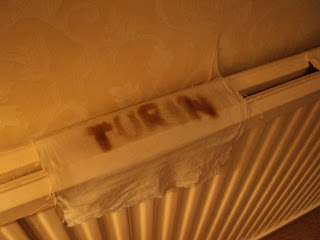As suggested earlier, I figured that a better result might be obtained by painting with aqueous charcoal suspension ("charcoal paint") , and that has indeed proved to be the case, as should be apparent from what follows.
The lump charcoal was first reduced to a powder with a hammer, and then a little water added to the powder. That did not give a satisfactory "paint", with a lot of charcoal floating on top. As soon as a few drops of detergent were added (washing-up liquid) a relatively homogenous paste was obtained that could easily be applied to fabric with a brush as if painting.
The following pictures should be self-explanatory:
Charcoal painted onto cloth, with paint pot in background
The next step is to dry the paint over a radiator.
Each letter of the painted word was then exposed to a few minutes radiant heat from a 60W ceiling spot lamp, and here it is viewed from the rear before washing out the charcoal "stencil". Faint smoke was visible during the roasting procedure, but nothing burst into flame. The pyrolysis (charring) seems to be self-limiting, and greatest in the regions with most paint.
Here it is, back on the radiator, drying off, after washing out the charcoal with soap and water (which proved exceptionally quick and easy). So that's a scorch image that is visible now, instead of the original charcoal.
Here we are, back on the dining table. looking at the thermo-stencilled image,and with no trace of charcoal visible that might give a clue as to how it was formed. Painting is definitely the way to go, as distinct from drawing, allowing one to build up the density of heat-absorbing pigment in stages until one gets the desired intensity of scorching. And it's much easier to wash out the charcoal, due presumably to far less pressure from painting with a brush.Could this be how the Turin Shroud was produced?
Next experiment? It is said that the image is not formed on the cellulose fibres, but on a surface coating of starch, the latter having been used as an aid to weaving:
Link
Evidence for this is that the image can apparently be stripped off physically with adhesive tape (which is certainly not the case for scorched cotton) or reduced chemically with diimide, N2H2.
So the next step is to repeat the experiments with a starch-coated fabric. It's my guess that scorching will occur more readily with starch, which is chemically more reactive alpha-linked glucan, than with cellulose (beta-linked glucan), the latter having more extensive crystallinity due to multiple intermolecular hydrogen bonding interactions. If scorching can be achieved quickly, then it may indeed be possible to strip off a superficial scorched layer from underlying cellulose, simulating more closely the characteristics of the Shroud. I shall have to think of an authentic (historically credible) source of starch. It certainly won't be potato starch!
























No comments:
Post a Comment